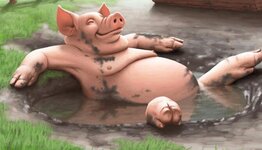DownNDirty
Bronze Member
The Swamp Pit kept calling my name... so I had no choice but to go back last Thursday.  Fortunately there had been no rain there during the previous few days so it had dried up a good bit but was still muddy. Heck I didn't care.
Fortunately there had been no rain there during the previous few days so it had dried up a good bit but was still muddy. Heck I didn't care.
I got right back in the glass shards where I left off and weeded through the myriad of shards and pottery. I dug down to what looked like just another upside down base shard, but when I tried to pull it out it wouldn't budge. I dug around it with my hands and soon realized that this was more than a base. I finally managed to pull it out and when I did the neck of the bottle fell out of the base. Turns out the two pieces fit together to form about 3/4 of a whole bottle-and it appears to be from about the 1730s or 40s.
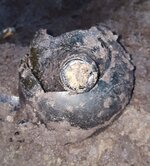
I later cleaned it , applied some super glue and it now resides in my display case.
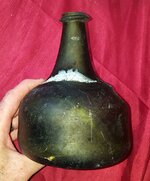
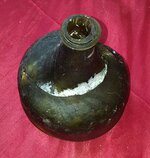
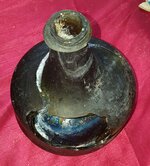
I was pretty happy about the good start to the day's dig and pressed on. Not too much later I dug a whole kaolin pipe bowl, in great condition. Minutes later I found two pipe stem pieces and low and behold they all fit together. This is only the second intact bowl I have found and to have several inches of the stem is pretty awesome.
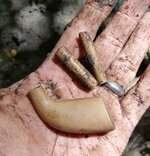
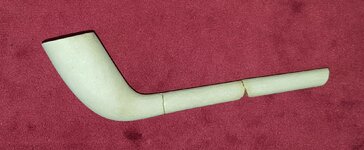
My luck continued; while digging through more black glass shards I came upon another base that was firmly stuck in the mud. I carefully dug around it with my fingers, thinking that at any time I would feel the broken end of the base-but it just kept going. When I managed to lift it out of the pit I was more than a bit surprised to find it completely intact, except for the lip and "string" being broken off. No cracks or chips whatsoever. This one is also from the 1730s/40s based on the shape.
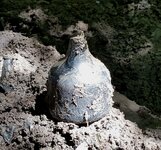
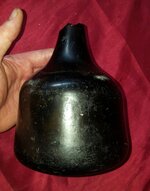
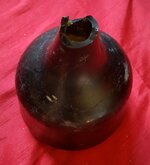
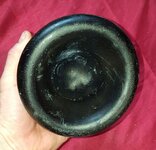
Mixed in with the glass were a lot of pottery shards, many of which were part of a large bowl and a jar that I am reconstructing (both from the 1700s). Over the past few days I have been matching up pieces and gluing them back together, and I now have the majority of the bowl reconstructed. It's actually a "milk pan" and they used them to separate cream from milk. After milking the cows they would pour it into the pan and let it sit for 12 to 24 hours. Then they would skim the cream off the top and make butter from it.
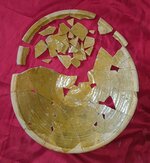
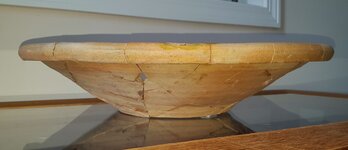
Here is what I have reconstructed of the jar so far; I hope to find more pieces of both in the near future.
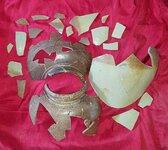
Other pottery and glass that I found; the green glass bottle top is from a pharmaceutical bottle:
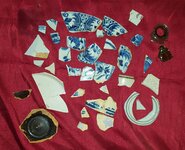
Another interesting find was this preserved piece of wood; it was buried in the pit so it would have been tossed during the 18th century. I first thought it was a gun stock, but the bottom is flat. Any ideas?
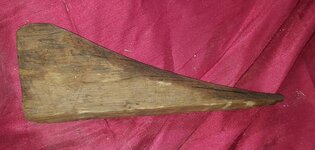
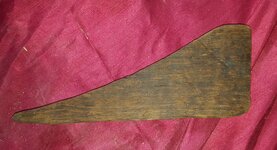
An interesting thing about digging trash pits is you get a good idea of the types of food that they ate "back in the day." Here are several cow leg bones; one of them has butcher marks on it:
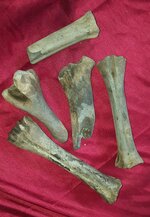
And here is a group shot of all of my finds for the day.
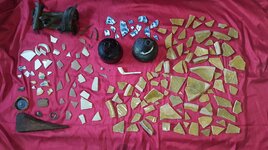
 To be continued...
To be continued... 
 Fortunately there had been no rain there during the previous few days so it had dried up a good bit but was still muddy. Heck I didn't care.
Fortunately there had been no rain there during the previous few days so it had dried up a good bit but was still muddy. Heck I didn't care.I got right back in the glass shards where I left off and weeded through the myriad of shards and pottery. I dug down to what looked like just another upside down base shard, but when I tried to pull it out it wouldn't budge. I dug around it with my hands and soon realized that this was more than a base. I finally managed to pull it out and when I did the neck of the bottle fell out of the base. Turns out the two pieces fit together to form about 3/4 of a whole bottle-and it appears to be from about the 1730s or 40s.

I later cleaned it , applied some super glue and it now resides in my display case.



I was pretty happy about the good start to the day's dig and pressed on. Not too much later I dug a whole kaolin pipe bowl, in great condition. Minutes later I found two pipe stem pieces and low and behold they all fit together. This is only the second intact bowl I have found and to have several inches of the stem is pretty awesome.


My luck continued; while digging through more black glass shards I came upon another base that was firmly stuck in the mud. I carefully dug around it with my fingers, thinking that at any time I would feel the broken end of the base-but it just kept going. When I managed to lift it out of the pit I was more than a bit surprised to find it completely intact, except for the lip and "string" being broken off. No cracks or chips whatsoever. This one is also from the 1730s/40s based on the shape.




Mixed in with the glass were a lot of pottery shards, many of which were part of a large bowl and a jar that I am reconstructing (both from the 1700s). Over the past few days I have been matching up pieces and gluing them back together, and I now have the majority of the bowl reconstructed. It's actually a "milk pan" and they used them to separate cream from milk. After milking the cows they would pour it into the pan and let it sit for 12 to 24 hours. Then they would skim the cream off the top and make butter from it.


Here is what I have reconstructed of the jar so far; I hope to find more pieces of both in the near future.

Other pottery and glass that I found; the green glass bottle top is from a pharmaceutical bottle:

Another interesting find was this preserved piece of wood; it was buried in the pit so it would have been tossed during the 18th century. I first thought it was a gun stock, but the bottom is flat. Any ideas?


An interesting thing about digging trash pits is you get a good idea of the types of food that they ate "back in the day." Here are several cow leg bones; one of them has butcher marks on it:

And here is a group shot of all of my finds for the day.

 To be continued...
To be continued... 
Amazon Forum Fav 👍
Last edited:
Upvote
38



 Those are some killer bottles and excellent reconstruction on that milk pan. The coolest thing are the organics that are preserved in your swamp mud... now, just to find a Colonial leather shoe or wool jacket! I can't wait to see what turns up next.
Those are some killer bottles and excellent reconstruction on that milk pan. The coolest thing are the organics that are preserved in your swamp mud... now, just to find a Colonial leather shoe or wool jacket! I can't wait to see what turns up next.

